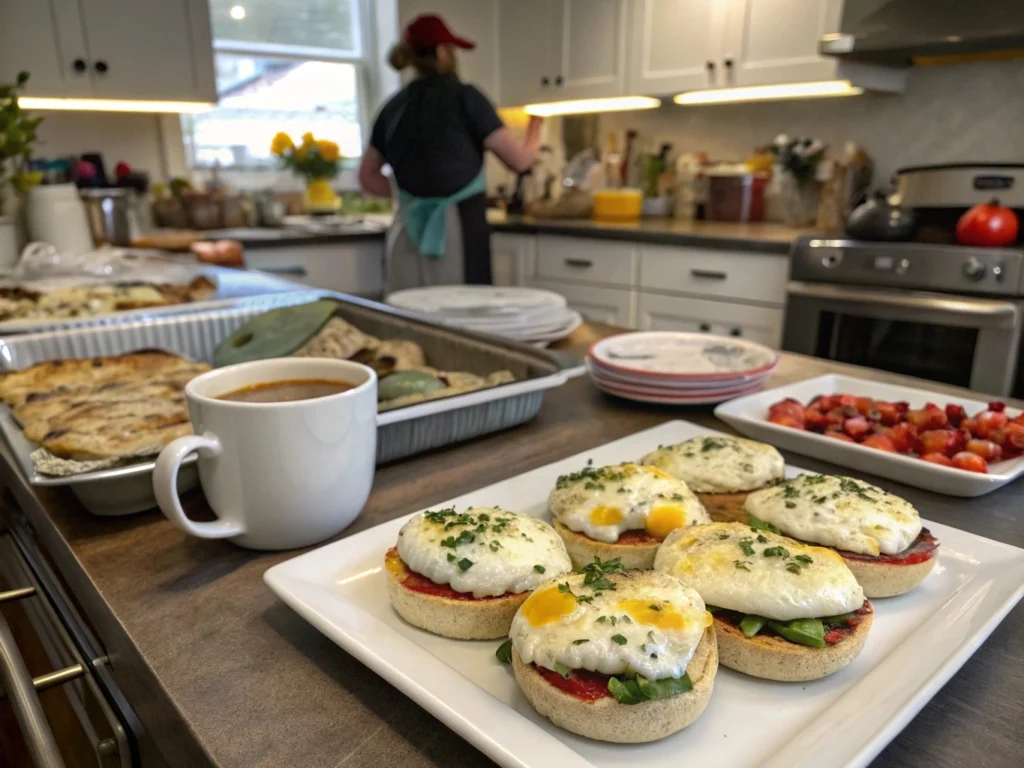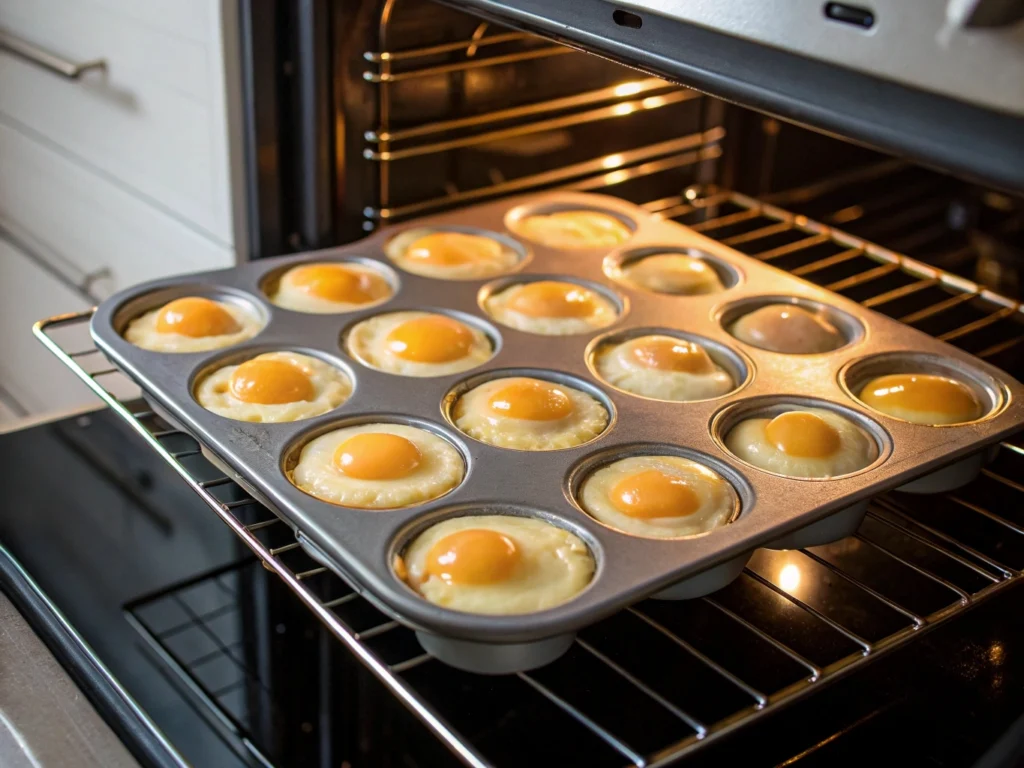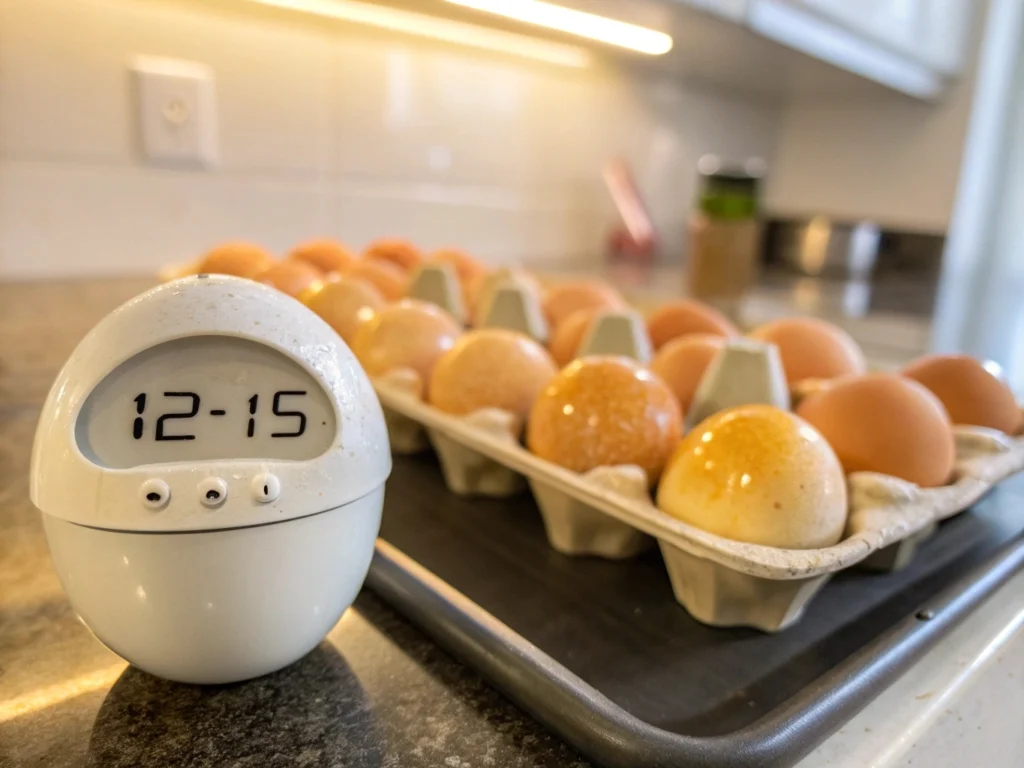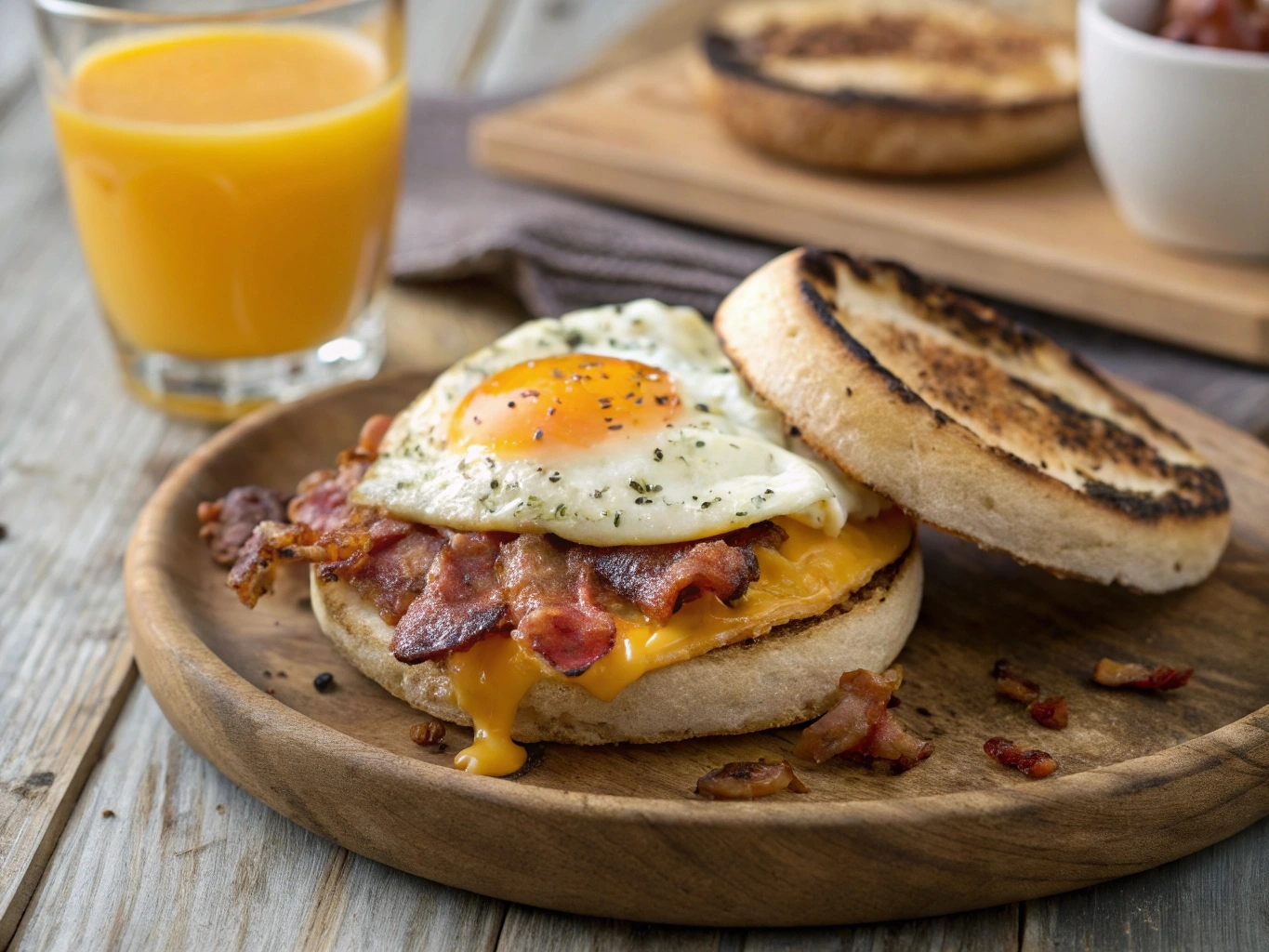A baked egg for sandwich is one of the easiest, most efficient ways to prepare perfectly shaped, delicious eggs for a quick and hassle-free breakfast. Instead of standing over a stovetop and flipping eggs, baking allows you to cook multiple eggs at once with consistent texture and shape, making them ideal for sandwiches.
Whether you’re meal prepping for the week or just want a foolproof method to create a fast, satisfying breakfast, this guide will walk you through everything you need to know. You’ll learn the best oven temperature, cooking time, storage tips, reheating tricks, and creative variations to make sure your baked egg for sandwich turns out perfect every time.
Table of Contents
Discover more delicious recipes and ideas by visiting our homepage!
Why Baked Eggs Are the Best for Sandwiches
Is It Safe to Bake Eggs in the Oven?
Yes! Baking eggs is completely safe as long as you follow the right cooking temperature and time. Unlike frying, baking provides even heat distribution, ensuring the eggs cook consistently without burning or overcooking.
Here’s why baking eggs is a safer and more convenient alternative:
- No Hot Oil Splatter – Unlike frying, baking removes the risk of oil burns or messy splatters.
- Hands-Free Cooking – You can bake multiple eggs at once while preparing other ingredients.
- Healthier Option – Uses less oil or butter, making it a lighter, lower-calorie choice.
Benefits of Baked Egg for Sandwich Breakfasts

A baked egg for sandwich has several advantages over fried or scrambled eggs:
✔ Perfect Shape – The eggs cook into a round, uniform shape that fits perfectly inside bagels, muffins, or toast.
✔ Batch Cooking Made Easy – You can bake 6-12 eggs at once, saving time for busy mornings.
✔ Customizable Flavor – Easily add cheese, herbs, or spices before baking for enhanced taste.
For more baked breakfast ideas, check out Baked Breakfast Sandwiches for additional creative recipes.
How to Bake Eggs for the Perfect Breakfast Sandwich

Baking eggs is simple, but small details make a big difference in texture and flavor.
How to Make a Round Egg for a Breakfast Sandwich
To achieve that classic round shape, use muffin tins, ramekins, or silicone molds. These ensure eggs stay in place while baking and result in a uniform size that fits perfectly in sandwiches.
Step-by-Step Instructions
- Preheat your oven to 350°F (175°C).
- Grease your muffin tin or ramekins with butter, oil, or cooking spray to prevent sticking.
- Crack one egg into each section and season with salt and pepper.
- Optional: Add shredded cheese, diced veggies, or herbs for extra flavor.
- Bake for 12-15 minutes, or until the egg whites are set and yolks reach the desired consistency.
💡 Pro Tip: If you prefer firmer yolks, bake for an additional 2-3 minutes.
Best Oven Temperature & Cooking Time for Baked Eggs
What Temperature Is Best for Baking Eggs?
- 350°F (175°C): Produces soft, slightly runny yolks (ideal for sandwiches).
- 375°F (190°C): Creates fully set whites and firmer yolks.
- 400°F (200°C): Cooks eggs quickly but may lead to drier texture.
How Long Do Eggs Cook in the Oven at 350 Degrees?
At 350°F, eggs generally take 12-15 minutes to bake fully. However, cooking time varies depending on your oven, the type of pan, and desired yolk texture:
- For a softer yolk: Bake 10-12 minutes.
- For a fully set yolk: Bake 14-16 minutes.
💡 Pro Tip: Always check eggs at the 10-minute mark to prevent overcooking.
Common Mistakes When Baking Eggs & How to Avoid Them
Even though baking eggs is easy, a few mistakes can affect the final texture and taste.
Mistake #1: Skipping the Grease
Eggs tend to stick to muffin tins if not properly greased. To avoid this:
✔ Use non-stick spray, butter, or oil before adding eggs.
✔ Opt for silicone molds, which make removal effortless.
Mistake #2: Overcooking the Eggs
Baked eggs continue cooking even after being removed from the oven. To prevent dry, rubbery eggs:
✔ Remove them as soon as the whites are set to retain softness.
✔ Let them rest for 2-3 minutes before serving.
For more egg preparation techniques, explore Baking Eggs for Sandwiches for additional methods.
How to Store & Reheat Baked Egg for Sandwich Meals
Baked eggs are perfect for meal prep because they store well and reheat easily without becoming rubbery.
Storage Tips
- Refrigeration: Store in an airtight container for up to 4 days.
- Freezing: Wrap each egg in plastic wrap or parchment paper before placing them in a freezer bag. They’ll last up to 3 months.
Best Ways to Reheat
- Microwave: Heat on medium power for 20-30 seconds.
- Toaster Oven: Bake at 300°F for 5 minutes for a crispier texture.
- Stovetop: Reheat on low heat for 2-3 minutes.
💡 Pro Tip: To prevent baked eggs from drying out, add a few drops of water before reheating in the microwave.
Creative Variations of Baked Eggs for Sandwiches
Baking eggs is already a game-changer for meal prep, but adding extra ingredients can take your sandwiches to the next level. Whether you love cheesy eggs, extra protein, or a spicy kick, these variations allow you to customize your baked egg for sandwich based on your taste and diet.
H2: Flavorful Add-Ins for Baked Eggs
Adding ingredients before baking infuses flavor and texture directly into the eggs. Here are some popular options:
- Cheese: Try shredded cheddar, Swiss, mozzarella, or crumbled feta for a creamy texture.
- Vegetables: Diced bell peppers, onions, mushrooms, or spinach add nutrients and crunch.
- Protein: Crumbled turkey sausage, smoked salmon, or cooked bacon enhance the flavor.
- Spices & Herbs: Paprika, black pepper, garlic powder, or fresh chives bring out a deeper taste.
H2: Can You Make Dairy-Free or Low-Carb Baked Eggs?
Absolutely! A baked egg for sandwich can be tailored to various dietary needs:
- Dairy-Free: Skip the cheese or use dairy-free alternatives like cashew or almond-based cheese.
- Low-Carb: Instead of bagels, serve baked eggs on lettuce wraps or almond flour biscuits.
- High-Protein: Add extra egg whites or lean meats like turkey bacon for a protein boost.
For more customizable breakfast ideas, check out Breakfast Sandwich Without Egg for delicious, egg-free variations.
Step-by-Step: How to Assemble the Perfect baked egg for sandwich
Now that your baked eggs are ready, it’s time to assemble your sandwich with the best combination of bread, toppings, and condiments.
H2: Best Breads for a baked egg for sandwich
The right bread makes all the difference. Consider these options:
- Classic English Muffin: Slightly crispy and the perfect size for round baked eggs.
- Bagels: A hearty, filling option that pairs well with melted cheese.
- Whole Wheat Toast: A lighter, healthier alternative with added fiber.
- Croissants: Buttery and flaky, perfect for an indulgent breakfast.
H2: Top Condiments for the Ultimate Breakfast Sandwich
- Classic Choices: Ketchup, mustard, or mayonnaise for a simple flavor boost.
- Creamy Options: Avocado spread, hollandaise sauce, or garlic aioli for richness.
- Spicy Toppings: Sriracha, hot sauce, or chipotle mayo for extra heat.
For delicious sauce ideas, explore Egg Sandwich Sauce to find the perfect pairing.
Meal Prep Tips for baked egg for sandwich
H2: How to Store Baked Egg Sandwiches for Meal Prep
If you’re preparing sandwiches ahead of time, storing them properly ensures they stay fresh and delicious.
✔ Refrigeration: Assemble sandwiches and wrap them in parchment paper or foil before storing in an airtight container. They’ll last up to 4 days.
✔ Freezing: Wrap each sandwich individually in plastic wrap, then place in a freezer bag. Frozen sandwiches last up to 3 months.
✔ Label and Date: Always mark the storage date to track freshness.
H2: Best Way to Reheat a Frozen Breakfast Sandwich
Reheating your baked egg for sandwich the right way ensures the best texture.
- Microwave: Wrap in a damp paper towel and heat for 60-90 seconds.
- Oven: Bake at 350°F for 10-12 minutes for a crispy result.
- Air Fryer: Heat at 350°F for 5-6 minutes for a crispier texture.
💡 Pro Tip: If your sandwich has cheese, add it after reheating to avoid sogginess.
FAQs: Common Questions About Baked Eggs for Is It Safe to Bake Eggs in the Oven?

Yes! Baking eggs in the oven is completely safe, provided you follow the right temperature and cooking guidelines. Unlike stovetop frying, which requires constant monitoring, baking allows for even heat distribution, ensuring that eggs cook consistently without burning or drying out.
However, it’s important to avoid overcooking, as eggs can become rubbery and dry if left in the oven too long. The ideal temperature range for baking eggs is 325°F to 375°F, depending on the desired texture. Using muffin tins, ramekins, or silicone molds helps maintain the eggs’ shape while preventing spills.
💡 Pro Tip: To keep baked eggs from drying out, consider adding a small splash of milk or cream to each egg before baking. This helps maintain moisture and creates a softer, creamier texture.
How to Make a Round Egg for a Breakfast Sandwich?

Achieving the perfect round shape for a baked egg for sandwich is easier than you might think. The key is to use the right baking dish or mold to contain the egg as it cooks.
Here are the best tools for making uniform, round eggs:
✔ Muffin tins: These create small, circular eggs that fit perfectly inside an English muffin or bagel.
✔ Ramekins: Ideal for a slightly thicker, restaurant-style egg, perfect for a croissant or toasted sandwich.
✔ Silicone molds: Non-stick and flexible, making it easy to remove eggs without breaking them.
💡 Pro Tip: If you want fluffy, uniform eggs, whisk them before pouring into the mold. Adding a pinch of salt, black pepper, or grated cheese enhances the flavor while keeping them light and airy.
How Long Do Eggs Cook in the Oven at 350 Degrees?
The cooking time for baked eggs depends on your desired yolk consistency. At 350°F, eggs generally take 12-15 minutes to reach the perfect texture.
Here’s a detailed breakdown based on doneness preference:
- For soft yolks: Bake for 10-12 minutes, keeping a slightly runny center.
- For medium-set yolks: Bake for 12-14 minutes, with a firmer consistency but still soft inside.
- For fully cooked yolks: Bake for 14-16 minutes, ensuring no liquid remains.
💡 Pro Tip: Always check eggs around the 10-minute mark to prevent overcooking. Since oven temperatures vary, you may need to adjust the time slightly for perfect results.
Can You Put a Raw Egg in the Oven?
Yes! You can bake a raw egg directly in the oven without any issue. Baking allows the egg white and yolk to cook evenly, eliminating the need for flipping or stirring.
To bake raw eggs properly:
✔ Use a greased muffin tin or ramekin to prevent sticking.
✔ Crack eggs carefully to keep the yolk intact if you prefer a whole baked egg for sandwich.
✔ Cover with foil if baking at a higher temperature to prevent excessive browning.
Baking eggs is a great way to prepare multiple servings at once while keeping cleanup minimal. Plus, it’s a mess-free alternative to frying on the stovetop!
What Temperature Is Best for Baking Eggs?
The ideal baking temperature depends on how you like your eggs. Here’s a quick guide to help you choose the best temperature for a baked egg for sandwich:
✔ 325°F-350°F: Produces soft, slightly runny yolks, perfect for a creamy sandwich filling.
✔ 375°F: A balanced temperature that ensures fully set whites while keeping the yolk slightly tender.
✔ 400°F: Best for quick cooking, but may result in firmer eggs with a slightly crisp edge.
💡 Pro Tip: If baking several eggs at once, lower the temperature slightly to 325°F-350°F and increase the cooking time by 2-3 minutes for even doneness.
What Is the Rule of Eggs in Baking?
Eggs are essential in baking because they provide structure, moisture, and richness to recipes. Whether you’re making cakes, breads, or a baked egg for sandwich, eggs help create the perfect texture.
Here’s how eggs contribute to baked dishes:
✔ Binding: Eggs help hold ingredients together, giving structure to baked goods and breakfast sandwiches.
✔ Moisture: The fat content in yolks keeps baked items soft and prevents dryness.
✔ Leavening: When beaten, eggs trap air, making baked dishes lighter and fluffier.
For sandwich prep, baking eggs ensures consistency in shape and texture, making them easier to stack and store. This method guarantees a delicious, homemade breakfast with minimal effort!
PrintBaked Egg for Sandwich
- Total Time: 17-20 minutes
- Yield: 6 baked eggs (enough for 6 sandwiches) 1x
Description
A baked egg for a sandwich is one of the easiest and most efficient ways to prepare perfectly shaped, delicious eggs for a quick and hassle-free breakfast. Instead of standing over a stovetop flipping eggs, this baking method allows you to cook multiple eggs at once with consistent texture and shape—perfect for sandwiches. Whether you’re meal prepping for the week or making a fresh breakfast, this recipe will ensure you have flavorful, protein-packed eggs that fit perfectly in bagels, English muffins, croissants, or toast.
Ingredients
- 6 large eggs
- ½ teaspoon salt
- ¼ teaspoon black pepper
- 1 tablespoon butter, oil, or non-stick cooking spray (for greasing)
- Optional add-ins:
- ½ cup shredded cheese (cheddar, mozzarella, or Swiss)
- ¼ cup diced bell peppers
- ¼ cup chopped spinach
- ¼ teaspoon garlic powder or paprika
Instructions
- Preheat Oven – Set your oven to 350°F (175°C).
- Prepare Muffin Tin – Lightly grease a 6-cup muffin tin, ramekins, or silicone molds with butter, oil, or non-stick cooking spray to prevent sticking.
- Crack Eggs – Crack one egg into each muffin cup. If you prefer scrambled-style eggs, whisk each egg before pouring.
- Season Eggs – Sprinkle with salt, black pepper, and any additional seasonings or toppings (cheese, diced veggies, etc.).
- Bake Eggs – Place the muffin tin in the oven and bake for 12-15 minutes or until the whites are set.
- For runny yolks: Bake for 10-12 minutes.
- For fully set yolks: Bake for 14-16 minutes.
- Cool & Remove – Let eggs cool for 2-3 minutes, then use a knife or spoon to gently remove them.
- Assemble Sandwich – Place a baked egg on your favorite bread (bagel, English muffin, toast, or croissant), add cheese, avocado, or condiments, and enjoy!
Notes
- Storage: Store baked eggs in an airtight container in the fridge for up to 4 days, or freeze individually wrapped eggs for up to 3 months.
- Reheating:
- Microwave: Heat for 20-30 seconds on medium power.
- Oven: Bake at 300°F (150°C) for 5 minutes.
- Air Fryer: Reheat at 350°F (175°C) for 3-4 minutes.
- Variations: Try adding ham, smoked salmon, or hot sauce for extra flavor!
- Low-Carb Option: Skip the bread and serve on lettuce wraps or keto-friendly buns.
Enjoy your Baked Egg for Sandwich and start your day with a quick, satisfying, and protein-packed breakfast! 🥪🥚
- Prep Time: 5 minutes
- Cook Time: 12-15 minutes
- Category: Breakfast
- Cuisine: American
Nutrition
- Serving Size: 1 egg per sandwich
- Calories: 1 egg per sandwich
- Fat: 5g
- Carbohydrates: 0g
- Protein: 6g
Conclusion: Why Baked Eggs are the Best for Sandwiches
A baked egg for sandwich is one of the easiest, most efficient ways to enjoy delicious, protein-packed breakfasts. Baking eggs ensures perfect shape, hands-free cooking, and easy meal prep, making it an ideal solution for busy mornings.
By following the tips in this guide, you can customize your baked eggs, store sandwiches for later, and enjoy a fresh, homemade breakfast anytime.
💡 Final Tip: Experiment with different seasonings, breads, and toppings to find your perfect breakfast combination!






1 thought on “Baked Egg for Sandwich: The Best Way to Make Breakfast Meal Prep Easy”